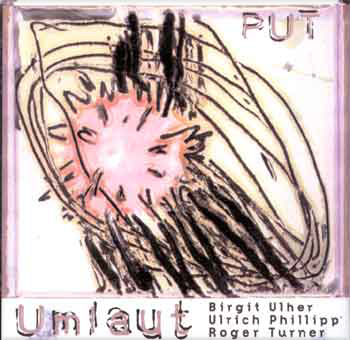
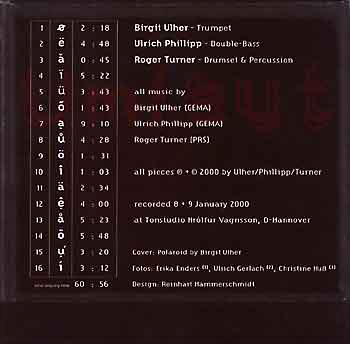
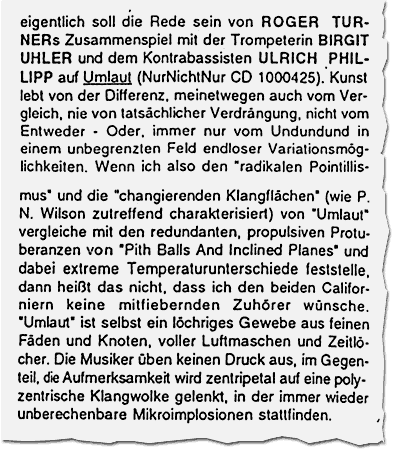
Bad Alchemy 36
Birgit Ulher,
Ulrich Phillipp
& Roger Turner
Umlaut
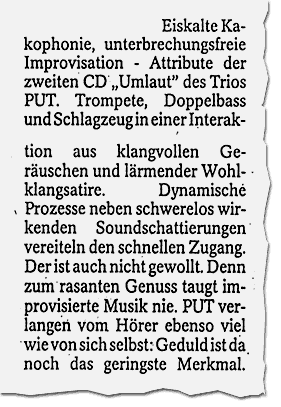
NRZ 25-07-2000
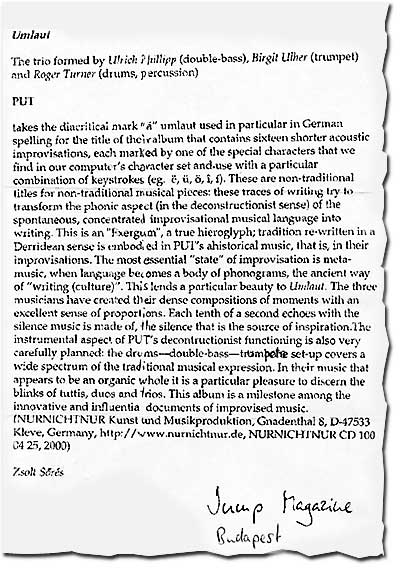
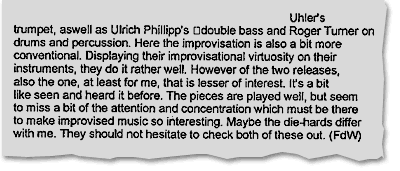
Frans de Waard at Vital Weekly 379
This CD brings you improvisation music Pur Sang, far more then is common in modern
jazz. Birgit Ulher (trumpet), Ulrich Phillipp (double-bass) and Roger Turner
(drumset & percussion) brings you music that is completely build on playing
with the sounds that their instruments can create and this in relationship
with the other instruments. They do not play notes, no they play with the typical
color textures their instruments can create. The power of the compositions
on this CD is not the constant flood of sounds but the briljant use of silence
between the color textures of the instruments.
This CD brings you 16 compositions of the most wonderfull improvisation music
in about 60 minutes. We recommend this CD to all who is interested in contemporary
music and jazz-improvisation.
Geert De Decker at Sztuka Fabryka

Vancouver Jazz / Bill Smith
Peter Niklas Wilson, in his sleeve notes to PUT's CD, makes the useful point that the casuity and lack of pretension of muscians like these can distract from the enormous technical effort of playing this sort of music. Because improv people tend to eshew muso posturing and glamourous images, they can appear as if they've just turned up and decided -- why not? -- to mess about with their instruments a bit.
This isn't helped by the visual element either: jeans and bagyy jumpers in the back rooms of unappealing venues are bad enough, but playing toys and household objects alongside a rather basic-looking drum kit is beyond the pale for most people. Why doesn't Roger Turner play "properly"? Is it because he can't? Well, no, it isn't, as an even marginally attentive listen through this disk will tell you. Turner is a striking drummer, with great command of dynamics and a wonderful range of off-the-cuff paradiddles, pattering around the kit with huge, restless energy. And, although it's a joy to watch him in the flesh, hearing him disembodied is a different experience, revealing the deep concentration which lies at the heart of his style.
Ulrich Phllipps has an impressive scope to his playing, switching easily from New Music compexity to jazzy lines to sound-based techniques with enormous confidence, an essential attribute for this kind of playing and one this trio demonstrates throughout the two sessions documented here. Birgit Ulher, too, brings forceful character to her music, made in large part of breath/mouth noises and extreme wah-wah effects. Her playing is sketchy and gestural, but in an appealing way which works.
Playing this kind of music is difficult in so many ways: technically, financially, logisticaly, psychologically. This is one of those recordings which shows what it can be like when everything is right. It's an example of the purest kind of free improv, a music which doesn't sound like jazz or new classical but which fits exactly and entirely into its own genre. Against those who don't believe that free improvisation is a fully-fledged genre as well as a technique, this would be an excellent witness to call.Another would be the music of the Three Pullovers (Beresford, Coombes and Smith) and the Four Pullovers (the same, with Day); recorded a quarter of a century before Umlaut's sessions, this is straight from it's ancestral gene pool. The Pulllovers lineups are reminiscent of John Stevens's SME, but the music is quite different. It sounds alien and somewhat aloof, as if it knows it will not be understood, like a Latin mass. There is something decidedly sinister, even threatening, about this music, something which gives fright simply by virtue of its unyielding strangeness, all of which is perhaps exacerbated by the detached.experience of listening to it on CD. The jokey track titles and the gawky band-name only make the whole thing more grotesque.
Far more that with PUT, it is almost impossible to attribute any given sound to any particular Pullover. The music here really embraces noise and texture, and strives to avoid repetition, predictability or the familiar. Of course, by that very token, much of this sounds quite familiar now, but that just means that the cleverness behind the music is more acessible to us than it must have been back then. Make no mistake, this is smart music which never sounds anarchic, never sounds like an art-school pose. Very cool, often nerve-jangling stuff.
Richard Cochrane